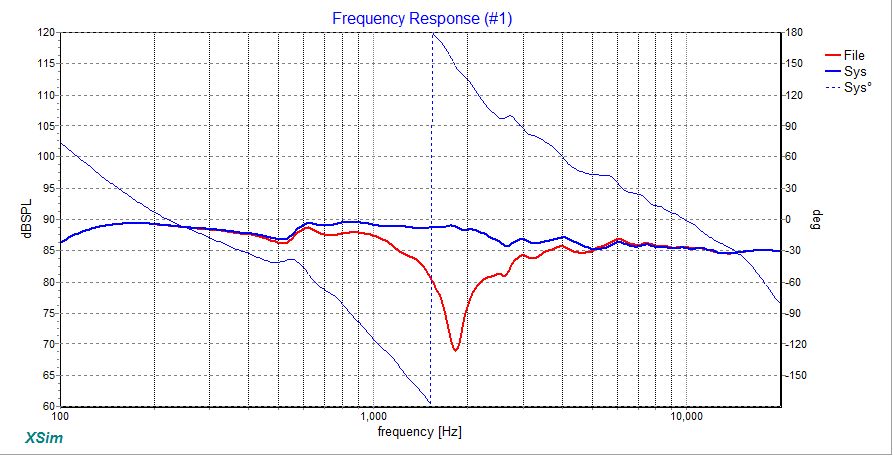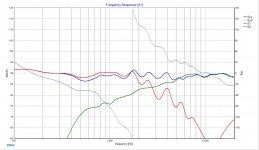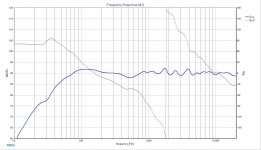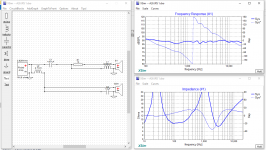Hi Everyone,
Just wanted to share an XSim model of the A26. It's reasonably accurate, but the raw driver data comes from images, so the impedance is pretty ragged.
Anyway, I though it might be a good reference in case anyone was curious, or a newbie wanted to play around with XSim or what not.
Best,
Erik
Just wanted to share an XSim model of the A26. It's reasonably accurate, but the raw driver data comes from images, so the impedance is pretty ragged.
Anyway, I though it might be a good reference in case anyone was curious, or a newbie wanted to play around with XSim or what not.
Best,
Erik
Hi,
but what are the 30,60,90° curves.... a 25 cm cone Sd means it beginns to be not pistonic around 1 000 Hz and start beaming jut a little above !
Maybe we could expect than a little 3 db dip off axis à la BBC study between 1 000 and 2 000 Hz is liked ?
Erik, did you ever listened this Kit ?
Aha, Troels would be flaten the impedance curve around the XO points as he did for the Proac D15 .... and maybe uses an AUDAX 35 mm driver... without the 10 ohm resistor in serie !
The four layers voice coils of the A26 driver certainly makes not the best drivers unit around, no ?
but what are the 30,60,90° curves.... a 25 cm cone Sd means it beginns to be not pistonic around 1 000 Hz and start beaming jut a little above !
Maybe we could expect than a little 3 db dip off axis à la BBC study between 1 000 and 2 000 Hz is liked ?
Erik, did you ever listened this Kit ?
Aha, Troels would be flaten the impedance curve around the XO points as he did for the Proac D15 .... and maybe uses an AUDAX 35 mm driver... without the 10 ohm resistor in serie !
The four layers voice coils of the A26 driver certainly makes not the best drivers unit around, no ?
Last edited:
Quick improvement by adding 0.68 mH as a 2nd order to the tweeter
Significantly better tweeter power handling, on-axis response,
driver phase still being ok. The XO point is pretty much defined
by the woofer's LP response, the only issue left being the tweeter's
HP and padding.
Significantly better tweeter power handling, on-axis response,
driver phase still being ok. The XO point is pretty much defined
by the woofer's LP response, the only issue left being the tweeter's
HP and padding.
Attachments
So the acoustic distance used for the woofer was estimated based on the published FR of the completed kit and interferometry.  In other words I moved the distance until my model matched the published FR. It's easily possible I made a mistake.
In other words I moved the distance until my model matched the published FR. It's easily possible I made a mistake.
Still, I like Lojzek's approach a great deal. I had tried to get fancy, by doing a 2nd order low pass and high pass filters, and that just went belly up. Lojzek's idea to just add a coil is pretty masterful.
So, adding an 0.91 mH coil I get to nearly perfect phase matching at the Xover point, but not the most symmetrical inverted response. However, as noted, this is just in simulation. The actual acoustic distance needs to be known.
Best,
Erik
Still, I like Lojzek's approach a great deal. I had tried to get fancy, by doing a 2nd order low pass and high pass filters, and that just went belly up. Lojzek's idea to just add a coil is pretty masterful.
So, adding an 0.91 mH coil I get to nearly perfect phase matching at the Xover point, but not the most symmetrical inverted response. However, as noted, this is just in simulation. The actual acoustic distance needs to be known.
Best,
Erik
Not a substitute for a real curve, but I've found this utility extraordinarily useful for extracting high resolution curves from images when the raw data is not available. Perhaps you've already used a similar tool to extract, but if not you might want to give this one a whirl. I'm in the process of building the A26, so will be following this thread.
BK
BK
Ground points are free you know. Use them liberally to reduce wiring.
Next, check your phase. Invert S1 and examine the FR plot. Should have a nice icicle form at the crossover point.
Turn off the system curve, and turn on S1 and S2, with phase to examine phase match directly.
Best,
Erik
Next, check your phase. Invert S1 and examine the FR plot. Should have a nice icicle form at the crossover point.
Turn off the system curve, and turn on S1 and S2, with phase to examine phase match directly.
Best,
Erik
Now is a good time to point out that those who build the A26 with the minimum crossover really like it that way. Everything I'm discussing from here especially forward is just for fun, but not a recommended right way.
Here's a good example from the LM-1 of what a close to ideal inverted FR should look The blue line is the normal version, the red line is what happens when you invert the tweeter on the LM-1. For more, go here.

Here's a good example from the LM-1 of what a close to ideal inverted FR should look The blue line is the normal version, the red line is what happens when you invert the tweeter on the LM-1. For more, go here.

Last edited:
Thinking of building this kit, would it suit a smallish carpeted living room paired with Tubleab SSE (single ended) running KT88's...about 8 watts? Am currently using Dynaudio Audience 52 standmounts (4ohm 87db) and the amp even with this speaker goes loud enough... I just think the easier load would be lapped up by the SE?
- Status
- This old topic is closed. If you want to reopen this topic, contact a moderator using the "Report Post" button.
- Home
- Loudspeakers
- Multi-Way
- Seas A26 Kit - Modelled in XSim


